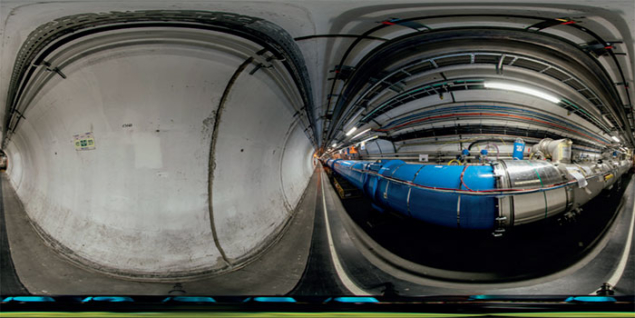

Image credit: M Brice/CERN.
Following a longer than usual technical stop, which began in December last year to allow for the replacement of the CMS inner tracker, all eight sectors of the Large Hadron Collider (LHC) have been cooled to their operating temperature of 1.9 K. The machine is now being prepared for the return of proton beams in May.
During the extended year-end technical stop (EYETS), one full sector of the LHC – lying between the ATLAS and ALICE experiments – was warmed up to room temperature to replace of one of its 15 m-long superconducting dipoles, which had exhibited abnormal behaviour on a few occasions during the 2016 physics run. The rest of the machine was maintained at 20 K. To make sure none of the LHC’s precious liquid-helium coolant would be lost during the EYETS interventions, the machine was emptied and its 130-tonne supply was temporarily stored on the surface.
Following the successful replacement and reconnection of the dipole magnet, pre-cooling of the sector to 80 K started on 17 February using 1200 tonnes of liquid nitrogen carried by 60 thermally insulated trucks, and was completed by 4 March. The re-filling of the arcs with liquid helium started about one week later, with electrical quality-assurance tests taking place at the end of the month. Powering tests took place during April, with the machine check-out scheduled for mid-April and the start of commissioning with beam during the first week of May.
Several other changes were made during the EYETS, not only to the LHC but also to the injectors. The PS Booster (PSB) underwent a massive de-cabling campaign, which has paved the way for the installation of new equipment for the LHC Injector Upgrade (LIU) project in the coming years. In response to a vacuum leak that developed in the SPS internal beam dump in April last year, a new internal beam dump was designed and constructed in record time and installed in the SPS. This will allow the SPS to reach its full performance again for the 2017 run, and in particular will lift the limit on the number of bunches for the LHC from 96 to 288 per SPS extraction.
With the LHC handed from the engineering department to the operations group on 14 April, the second phase of LHC Run 2 will soon be under way, with first collisions due approximately end of May.








